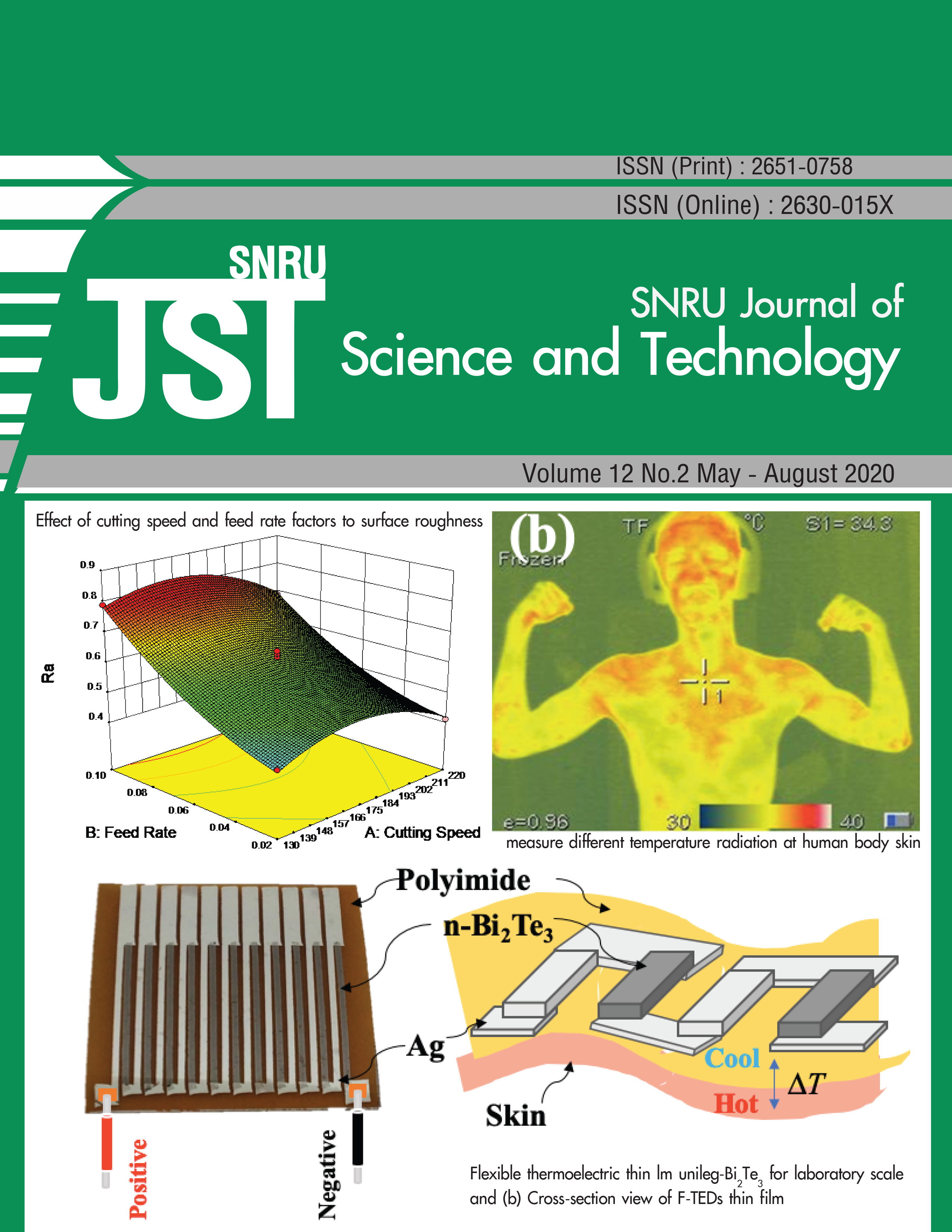Application of response surface methodology for optimization of cutting parameters for surface roughness and tool wear in turning of aluminum casting semi-solid 7075
Keywords:
CNC turning machine, Aluminum casting semi-solid, Surface roughness, Response surface methodologyAbstract
The objectives of this research were to determine the optimal cutting parameters and to predict the surface roughness and tool wear in turning process for aluminum casting semi-solid 7075 using the response surface methodology based on the Box-Behnken design. The cutting parameters investigated in this study included cutting speed, feed rate, and depth of cut. From the experiment, it was found that the main factors resulting in surface roughness were cutting speed, feed rate, and depth of cut. The optimal cutting conditions that provided for the surface roughness of 0.34 µm. were the cutting speed of 220 m. min–1, feed rate of 0.02 mm. rev–1, and depth of cut of 0.45 mm. Furthermore, the wear mechanism was taken place by cutting speed, feed rate and depth of cut. The pattern of wear was similar to cracking of mechanical fatigue, such as notch wear and crater wear.
References
S. Chanphong, S. Tangsitcharoen, Surface roughness prediction in turning process by utilizing response surface method, IE Network Conference, Chonburi, Thailand. 20 – 21 October 2011, 748 – 752.
W. Boonrawd, T. Ratanawilai, Effect of turning parameters on surface roughness of aluminum casting semi-solid, EITR&D. 23 (2012) 73 – 77.
S. Thamizhmanii, S. Hasan, Analyses of roughness, forces and wear in turning gray cast iron, JAMME. 1 – 2 (2006) 401 – 404.
D. Manivel, R. Gandhinathan, Optimization of surface roughness and tool wear in hard turning of austempered ductile iron (grade 3) using Taguchi method, Measurement. 93 (2016) 108 – 116.
S. Rawangwong, W. Cheewawuttipong, C Homkhiew, R. Burapa, Influence of factors affecting surface roughness and tools wear in turning process of semi-solid aluminum cast 356, OR-NET, Chonburi, Thailand. 25 – 27 March 2015, 134 – 139.
S. Rawangwong, C. Homkhiew, W. Cheewawuttipong, Optimizing condition and surface roughness prediction in turning process of aluminum casting semi-solid 6061 using response surface methodology, OR-NET, Bangkok, Thailand. 24 – 25 March 2016, 208 – 218.
R. Burapa, S. Janudom, T. Chucheep, R. Canyook, J. Wannasin, Effects of primary phase morphology on mechanical properties of Al-Si-Mg-Fe alloy in semi-solid slurry casting process, Trans. Nonferrous Met. Soc. China. 20 (2010) 857 – 861.
J. Wannasin, Semi-solid casting technique for aluminum alloy, National Metal and Materials Technology Center, Thai Foundry Association, Bangkok, 2011.
I. Meddour, M.A. Yallese, H. Bensouilah, A. Khellaf, M. Elbah, Prediction of surface roughness and cutting forces using RSM, ANN, and NSGA-II in finish turning of AISI 4140 hardened steel with mixed ceramic tool, IJAMT. 97 (2018) 1931 – 1949.
J.S. Dureja, R. Singh, M.S. Bhatti, Optimizing flank wear and surface roughness during hard turning of AISI D3 steel by Taguchi and RSM methods, Production & Manufacturing Research. 2 (2014) 767 – 783.
A.J. Makadia , J.I. Nanavati, Optimization of machining parameters for turning operations based on response surface methodology, Measurement. 46 (2013) 1521 – 1529.
L. Bouzid, M.A. Yallese, K. Chaoui, T. Mabrouki, L. Boulanouar, Mathematical modeling for turning on AISI 420 stainless steel using surface response methodology, Proc IMechE Part B: J Engineering Manufacture. 229 (2015) 45 – 61.
H. Tebassia, M.A. Yallesea, S. Belhadia, F. Girardinb, T. Mabroukic, Quality-productivity decision making when turning of Inconel 718 aerospace alloy: A response surface methodology approach, Int. J. Ind. Eng. Comput. 8 (3) (2017) 347 – 362.
A. Labidi, H. Tebassi, S. Belhadi, R. Khettabi, M. A. Yallese, Cutting conditions modeling and optimization in hard turning using RSM, ANN and desirability function, JFAP. 18 (2018) 1017 – 1033.
P. Chutima, Design of experiment for engineering, Chulalongkorn University Press, Bangkok, 2002.
P. Sudasna-na-Ayudthya, P. Luangpaiboon, Design and analysis of experiments, Top Publishing, Bangkok, 2008.
D.C. Montgomery, Design and analysis of experiments, 7th ed, John Wiley & Sons Inc, New York, 2012.
C. Saikaew, N. Chillapat, Experimental design for product and process improvement: an application in bottle glass crushing machine, KKU Engineering Journal. 33 (2006) 415 – 430.









